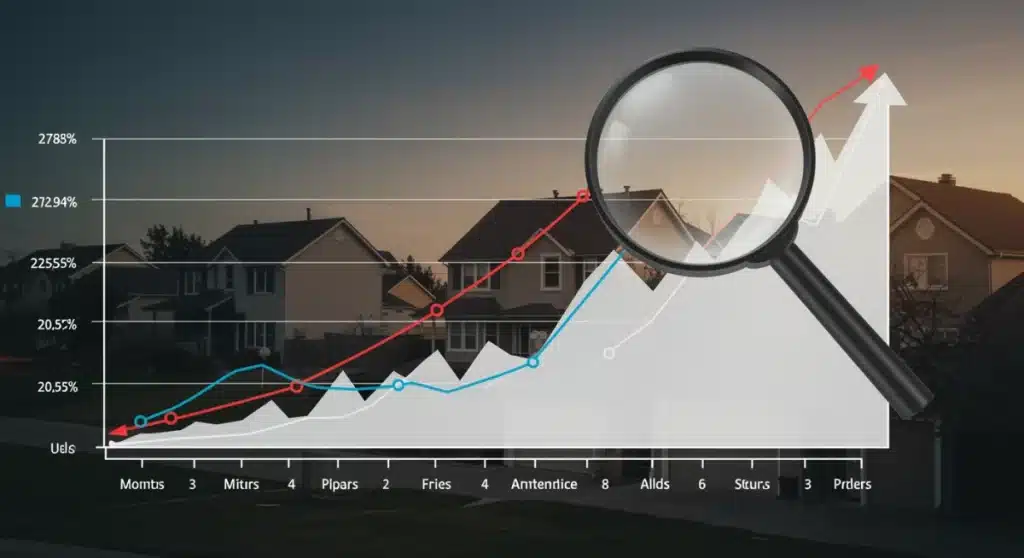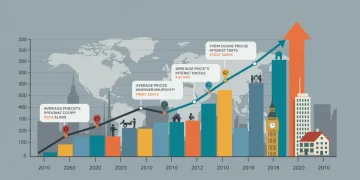3-Month Shift in National Home Prices: Buyers & Sellers Guide

Recent data indicates a notable 3-month shift in national home prices, compelling both buyers and sellers to reassess strategies amidst evolving market conditions.
The real estate market is in constant flux, and the past three months have brought significant changes to national home prices. As of early [Current Month, e.g., June] 2024, new data reveals crucial shifts that directly impact anyone looking to buy or sell a home. Understanding these recent updates is essential for navigating the current landscape effectively.
Understanding the Recent Price Movements
The national housing market has experienced a dynamic period over the last 90 days. Recent reports, including those from the National Association of Realtors (NAR) and various housing market indices, indicate a complex picture of both appreciation and localized cooling. While some regions continue to see robust price growth, others are beginning to stabilize or even slightly retract, reflecting a broader market recalibration.
This three-month window, from [Three Months Ago, e.g., March] to [Current Month, e.g., May] 2024, has been characterized by several key economic indicators influencing consumer confidence and affordability. Mortgage rates, inflation, and inventory levels have all played significant roles in shaping these price movements. Buyers and sellers must look beyond national averages and consider regional nuances.
Key Factors Influencing Prices
Several intertwined factors are currently driving the observed shifts in national home prices. These include the persistent, albeit easing, inflation rates, the Federal Reserve’s stance on interest rates, and the evolving supply-demand dynamics within local markets. Mortgage rates, in particular, remain a dominant force.
- Mortgage Rates: Fluctuations in the 30-year fixed mortgage rate have directly impacted buyer purchasing power, leading to adjustments in demand.
- Inflation: While showing signs of cooling, inflation continues to influence construction costs and overall economic sentiment, indirectly affecting home valuations.
- Inventory Levels: Low housing inventory in many desirable areas continues to exert upward pressure on prices, despite other market headwinds.
- Regional Economic Health: Local job growth, population shifts, and economic stability are increasingly dictating price performance in specific metropolitan areas.
Regional Disparities in Home Price Changes
While national home price trends provide a general overview, a deeper dive into regional data reveals significant disparities. The latest 3-month shift shows that certain areas are outperforming others, creating a fragmented market landscape. This divergence highlights the importance of localized analysis for both buyers and sellers.
For example, markets in the Sun Belt states, which saw explosive growth during the pandemic, are now experiencing varied trajectories. Some are still appreciating steadily, while others are seeing more pronounced corrections. Conversely, some historically stable markets in the Midwest are showing surprising resilience and even modest gains, according to recent analyses from CoreLogic.
Hot Markets vs. Cooling Markets
Identifying which markets are hot and which are cooling is crucial for making timely decisions. Hot markets are typically characterized by strong job growth, limited inventory, and sustained buyer demand. Cooling markets, on the other hand, may be experiencing an increase in listing times, price reductions, and a more balanced supply-demand ratio.
- Hot Markets: Areas like parts of the Southeast (e.g., Florida, Carolinas) and specific tech hubs continue to exhibit strong year-over-year price growth, albeit at a slower pace than previous years.
- Cooling Markets: Some Western markets (e.g., parts of California, Idaho) that saw unsustainable growth are now seeing more significant price adjustments, with some even reporting minor declines over the last three months.
- Stable Markets: Many Midwestern and Northeastern markets are showing more consistent, moderate growth, less prone to dramatic swings.
These regional differences underscore that there is no single national housing market, but rather a collection of local markets each responding to unique economic and demographic pressures. Buyers and sellers must consult local real estate professionals to gain accurate insights into their specific market conditions.
Impact on Homebuyers: Navigating Higher Costs
The latest 3-month shift in national home prices presents a mixed bag for prospective homebuyers. While some markets are seeing slight price decelerations, overall affordability remains a significant challenge due to elevated mortgage rates and, in many areas, still-high home values. Buyers are increasingly strategic in their approach.
Many first-time buyers are finding it particularly difficult to enter the market, often requiring larger down payments or accepting smaller homes. Repeat buyers, however, may have equity from previous sales to leverage, though they too face the hurdle of higher monthly mortgage payments compared to just a few years ago. The current environment demands careful financial planning and realistic expectations.
Strategies for Buyers in the Current Market
Given the evolving market conditions, homebuyers need to adopt adaptive strategies. This includes securing pre-approval for mortgages, being flexible with location, and understanding negotiation dynamics. The days of waived contingencies might be waning in some areas, offering buyers more leverage.
- Get Pre-Approved: A solid pre-approval letter strengthens your offer and clarifies your budget in a competitive environment.
- Be Flexible: Consider expanding your search to include less-sought-after neighborhoods or properties that might require minor renovations.
- Understand Negotiation: In some cooling markets, buyers may have more room to negotiate on price, repairs, or closing costs.
- Monitor Mortgage Rates: Stay informed about interest rate movements and be prepared to lock in a favorable rate when available.
Implications for Home Sellers: Adjusting Expectations
For home sellers, the recent 3-month shift in national home prices necessitates an adjustment in expectations compared to the frenzied seller’s markets of the past two years. While home values generally remain elevated historically, the pace of appreciation has slowed, and buyers are becoming more discerning. Sellers are now facing a market that demands more strategic pricing and presentation.
Homes are, on average, staying on the market slightly longer across the nation, and multiple-offer scenarios are less common, especially for properties that are not priced acutely or show minor deficiencies. Sellers who adapt quickly to these new realities are more likely to achieve their goals, according to recent market analysis from Zillow.

Effective Selling Strategies Now
Successful selling in the current climate involves a combination of competitive pricing, strategic marketing, and an understanding of buyer priorities. Overpricing a home can lead to prolonged market time and eventual price reductions, often below what a realistic initial price would have fetched.
- Realistic Pricing: Price your home competitively based on recent comparable sales in your immediate area, not just on peak market values.
- Enhance Curb Appeal: First impressions matter more than ever. Invest in minor landscaping improvements and ensure the exterior is inviting.
- Staging and Repairs: Present your home in its best light. Consider professional staging and address any minor repairs before listing.
- Marketing Matters: Utilize high-quality photography, virtual tours, and targeted online advertising to reach a broader audience.
The Role of Economic Indicators in Future Trends
The trajectory of national home prices in the coming months will largely depend on key economic indicators. The Federal Reserve’s monetary policy decisions, particularly regarding the federal funds rate, will continue to exert significant influence on mortgage rates. Any signals of sustained inflation decline could lead to rate cuts, potentially boosting buyer demand.
Additionally, employment figures and consumer confidence surveys offer valuable insights into the broader economic health and potential buyer enthusiasm. A strong job market typically supports housing demand, while economic uncertainty can lead to a more cautious approach from prospective buyers. Monitoring these indicators is crucial for anticipating future market shifts.
What to Watch For
Prospective buyers and sellers should keep a close eye on several economic reports and announcements. These can provide early warnings or confirmations of shifts in the housing market. Staying informed allows for more agile decision-making.
- Federal Reserve Announcements: Pay attention to statements regarding interest rates and economic outlook.
- Inflation Reports: Consumer Price Index (CPI) and Producer Price Index (PPI) data can signal future mortgage rate movements.
- Employment Data: Monthly jobs reports, including unemployment rates and wage growth, indicate economic strength.
- Housing Starts and Permits: These indicators point to future housing supply, which impacts price dynamics.
Expert Projections and What They Mean
Real estate analysts and economists are offering varied projections for the remainder of 2024 and beyond, reflecting the current market’s complexity. While some anticipate continued stabilization with modest appreciation, others foresee potential localized corrections, particularly in overvalued markets. The consensus suggests a more balanced market than seen in recent years, moving away from the extreme seller’s advantage.
According to leading housing economists from Fannie Mae and Freddie Mac, the rapid growth seen previously is unlikely to return soon. Instead, a period of more sustainable, single-digit appreciation is expected in many areas, coupled with increased inventory. This shift could offer a window of opportunity for buyers who have been sidelined by affordability issues, while sellers may need to adjust their pricing strategies to align with current demand and supply.
Navigating the Evolving Landscape
Both buyers and sellers will benefit from proactive engagement with market data and expert advice. The days of passive participation are over; strategic action is now paramount. Understanding the fundamental forces at play—from interest rates to local economic health—will empower individuals to make informed decisions that align with their financial goals. The market currently favors those who are well-prepared and adaptable.
For buyers, this might mean being ready to act quickly when a well-priced property emerges and being open to slightly higher interest rates if they secure a desirable home. For sellers, it involves understanding that while the market is still strong, it requires a more nuanced approach to pricing and presentation to attract serious buyers. The overarching theme is one of careful consideration and informed action rather than reactive decisions based on past market conditions.
| Key Aspect | Recent 3-Month Shift |
|---|---|
| National Home Prices | Varied trends; overall stabilization with localized appreciation and minor corrections. |
| Mortgage Rates | Fluctuations continue to impact buyer affordability and demand significantly. |
| Market Dynamics | Shift towards a more balanced market, with increased inventory in some areas. |
| Buyer/Seller Strategy | Buyers need flexibility; sellers require realistic pricing and enhanced presentation. |
Frequently Asked Questions About Home Price Shifts
The national trend shows a shift towards stabilization. While some regions still experience appreciation, the rapid growth seen in previous years has moderated, with certain markets even seeing minor corrections, according to recent NAR data.
Mortgage rates directly impact buyer affordability and demand. Higher rates reduce purchasing power, leading to fewer buyers and potentially slower price growth or even declines, whereas lower rates can stimulate demand and push prices up.
While a significant national drop isn’t widely predicted, localized corrections are possible in overvalued markets. Most experts anticipate a period of more moderate, sustainable growth rather than a widespread crash, balancing supply and demand.
Buyers should get pre-approved, be flexible with location and property type, and be prepared to negotiate. Monitoring interest rates and local market conditions is crucial for identifying opportune moments to make an offer.
Sellers need to price homes realistically based on recent comps, enhance curb appeal, and consider staging. Effective marketing and being open to negotiation will help attract serious buyers in a more balanced market.
Looking Ahead: What Happens Next
The current 3-month shift in national home prices signals a move towards a more rational and balanced real estate market. As interest rates, inflation, and inventory levels continue to evolve, both buyers and sellers must remain agile and informed. Future developments will largely hinge on the Federal Reserve’s next moves and the resilience of the job market. Expect continued regional variations, emphasizing the need for localized strategies rather than broad assumptions. Monitoring these key indicators will be paramount for predicting the next phase of housing market activity and making sound real estate decisions in the coming months.





